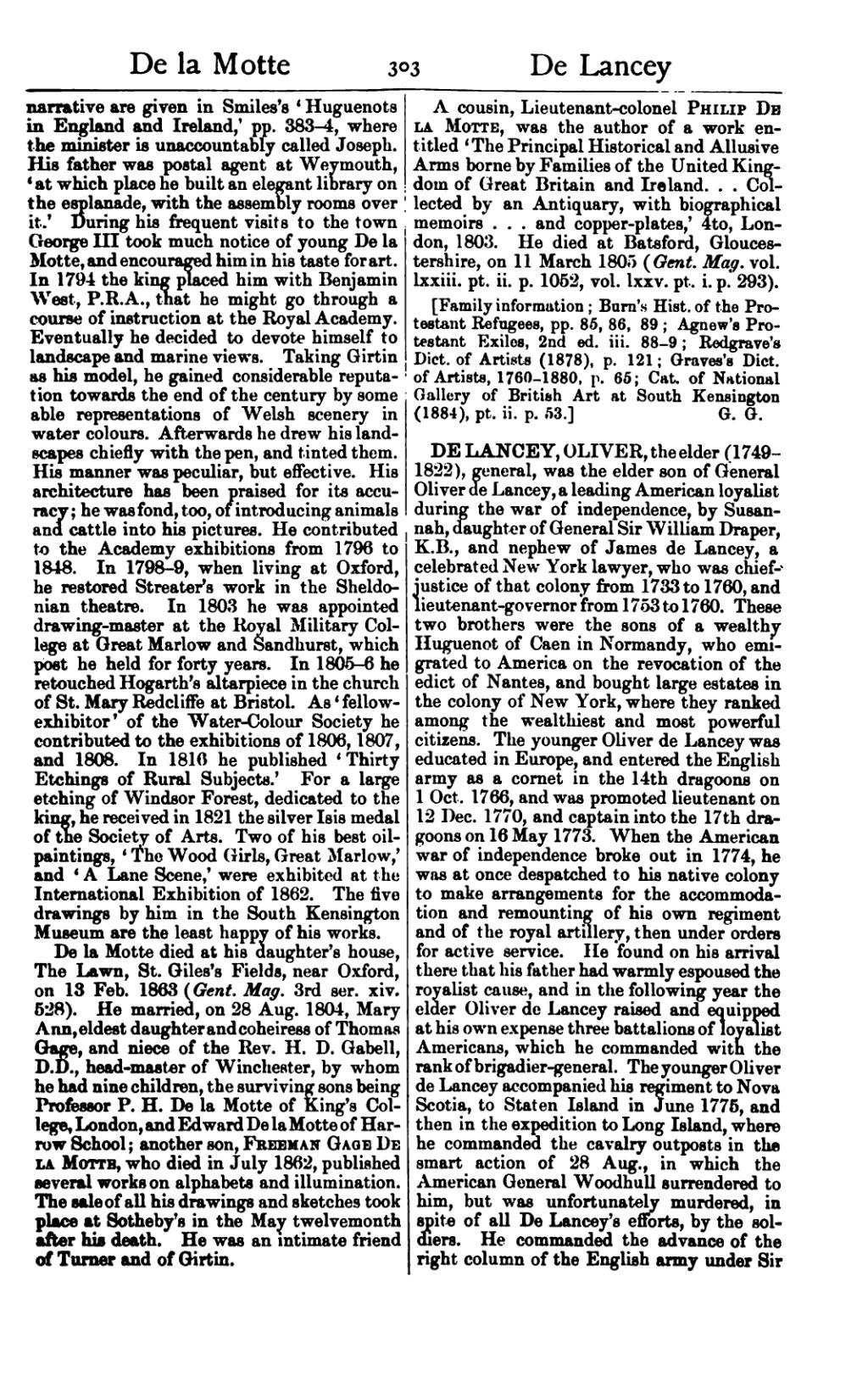narrative are given in Smiles's ‘Huguenots in England and Ireland,’ pp. 383–4, where the minister is unaccountably called Joseph. His father was postal agent at Weymouth, ‘at which place he built an elegant library on the esplanade, with the assembly rooms over it.’ During his frequent visits to the town George III took much notice of young De la Motte, and encouraged him in his taste for art. In 1794 the king placed him with Benjamin West, P.R.A., that he might go through a course of instruction at the Royal Academy. Eventually he decided to devote himself to landscape and marine views. Taking Girtin as his model, he gained considerable reputation towards the end of the century by some able representations of Welsh scenery in water colours. Afterwards he drew his landscapes chiefly with the pen, and tinted them. His manner was peculiar, but effective. His architecture has been praised for its accuracy; he was fond, too, of introducing animals and cattle into his pictures. He contributed to the Academy exhibitions from 1796 to 1848. In 1798–9, when living at Oxford, he restored Streater's work in the Sheldonian theatre. In 1803 he was appointed drawing-master at the Royal Military College at Great Marlow and Sandhurst, which post he held for forty years. In 1805–6 he retouched Hogarth's altarpiece in the church of St. Mary Redcliffe at Bristol. As ‘fellow-exhibitor’ of the Water-Colour Society he contributed to the exhibitions of 1806, 1807, and 1808. In 1816 he published ‘Thirty Etchings of Rural Subjects.’ For a large etching of Windsor Forest, dedicated to the king, he received in 1821 the silver Isis medal of the Society of Arts. Two of his best oil-paintings, ‘The Wood Girls, Great Marlow,’ and ‘A Lane Scene,’ were exhibited at the International Exhibition of 1862. The five drawings by him in the South Kensington Museum are the least happy of his works.
De la Motte died at his daughter's house, The Lawn, St. Giles's Fields, near Oxford, on 13 Feb. 1863 (Gent. Mag. 3rd ser. xiv. 528). He married, on 28 Aug. 1804, Mary Ann, eldest daughter and coheiress of Thomas Gage, and niece of the Rev. H. D. Gabell, D.D., head-master of Winchester, by whom he had nine children, the surviving sons being Professor P. H. De la Motte of King's College, London, and Edward De la Motte of Harrow School; another son, Freeman Gage De La Motte, who died in July 1862, published several works on alphabets and illumination. The sale of all his drawings and sketches took place at Sotheby's in the May twelvemonth after his death. He was an intimate friend of Turner and of Girtin.
A cousin, Lieutenant-colonel Philip De La Motte, was the author of a work entitled ‘The Principal Historical and Allusive Arms borne by Families of the United Kingdom of Great Britain and Ireland … Collected by an Antiquary, with biographical memoirs … and copper-plates,’ 4to, London, 1803. He died at Batsford, Gloucestershire, on 11 March 1805 (Gent. Mag. vol. lxxiii. pt. ii. p. 1052, vol. lxxv. pt. i. p. 293).
[Family information; Burn's Hist. of the Protestant Refugees, pp. 85, 86, 89; Agnew's Protestant Exiles, 2nd ed. iii. 88–9; Redgrave's Dict. of Artists (1878), p. 121; Graves's Dict. of Artists, 1760–1880, p. 65; Cat. of National Gallery of British Art at South Kensington (1884), pt. ii. p. 53.]
DE LANCEY, OLIVER, the elder (1749–1822), general, was the elder son of General Oliver de Lancey, American loyalist during the war of independence (whose daughter Susannah married General Sir William Draper, K.B.), and nephew of James de Lancey, a celebrated New York lawyer, who was chief-justice of that colony from 1733 to 1760, and lieutenant-governor from 1753 to 1760. These two brothers were the sons of a wealthy Huguenot of Caen in Normandy, who emigrated to America on the revocation of the edict of Nantes, and bought large estates in the colony of New York, where they ranked among the wealthiest and most powerful citizens. The younger Oliver de Lancey was educated in Europe, and entered the English army as a cornet in the 14th dragoons on 1 Oct. 1766, and was promoted lieutenant on 12 Dec. 1770, and captain into the 17th dragoons on 16 May 1773. When the American war of independence broke out in 1774, he was at once despatched to his native colony to make arrangements for the accommodation and remounting of his own regiment and of the royal artillery, then under orders for active service. He found on his arrival there that his father had warmly espoused the royalist cause, and in the following year the elder Oliver de Lancey raised and equipped at his own expense three battalions of loyalist Americans, which he commanded with the rank of brigadier-general. The younger Oliver de Lancey accompanied his regiment to Nova Scotia, to Staten Island in June 1775, and then in the expedition to Long Island, where he commanded the cavalry outposts in the smart action of 28 Aug., in which the American General Woodhull surrendered to him, but was unfortunately murdered, in spite of all De Lancey's efforts, by the soldiers. He commanded the advance of the right column of the English army under Sir

